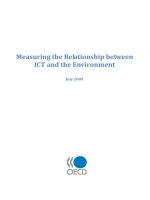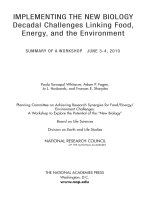Light in Engineering, Architecture and the Environment pdf
Bạn đang xem bản rút gọn của tài liệu. Xem và tải ngay bản đầy đủ của tài liệu tại đây (15.08 MB, 273 trang )
Light in Engineering, Architecture
and the Environment
WIT
eLibrary
Home of the Transactions of the Wessex Institute.
Papers presented at Light 2011 are archived in the WIT elibrary in volume 121 of
WIT Transactions on the Built Environment (ISSN: 1743-3509).
The WIT electronic-library provides the international scientific community with
immediate and permanent access to individual papers presented at WIT conferences.
.
WIT Press publishes leading books in Science and Technology.
Visit our website for the current list of titles.
www.witpress.com
LIGHT IN ENGINEERING, ARCHITECTURE
AND THE ENVIRONMENT
CONFERENCE CHAIRMEN
K. Domke
Poznan University of Technology, Poland
C.A. Brebbia
Wessex Institute of Technology, UK
INTERNATIONAL SCIENTIFIC ADVISORY COMMITTEE
Organised by
Wessex Institute of Technology, UK
Poznan University of Technology, Poland
Sponsored by
WIT Transactions on the Built Environment
FIRST INTERNATIONAL CONFERENCE ON LIGHTING IN
ENGINEERING, ARCHITECTURE AND THE ENVIRONMENT
W. Bonenberg
D. Gasparovsky
J. Grzonkowski
R. Nawrowski
P. Rombauts
J. Schanda
J. Suchanek
W. Zagan
WIT Transactions
Editorial Board
Transactions Editor
Carlos Brebbia
Wessex Institute of Technology
Ashurst Lodge, Ashurst
Southampton SO40 7AA, UK
Email:
B Abersek University of Maribor, Slovenia
Y N Abousleiman University of Oklahoma,
USA
P L Aguilar University of Extremadura, Spain
K S Al Jabri Sultan Qaboos University, Oman
E Alarcon Universidad Politecnica de Madrid,
Spain
A Aldama IMTA, Mexico
C Alessandri Universita di Ferrara, Italy
D Almorza Gomar University of Cadiz,
Spain
B Alzahabi Kettering University, USA
J A C Ambrosio IDMEC, Portugal
A M Amer Cairo University, Egypt
S A Anagnostopoulos University of Patras,
Greece
M Andretta Montecatini, Italy
E Angelino A.R.P.A. Lombardia, Italy
H Antes Technische Universitat Braunschweig,
Germany
M A Atherton South Bank University, UK
A G Atkins University of Reading, UK
D Aubry Ecole Centrale de Paris, France
H Azegami Toyohashi University of
Technology, Japan
A F M Azevedo University of Porto, Portugal
J Baish Bucknell University, USA
J M Baldasano Universitat Politecnica de
Catalunya, Spain
J G Bartzis Institute of Nuclear Technology,
Greece
A Bejan Duke University, USA
M P Bekakos Democritus University of
Thrace, Greece
G Belingardi Politecnico di Torino, Italy
R Belmans Katholieke Universiteit Leuven,
Belgium
C D Bertram The University of New South
Wales, Australia
D E Beskos University of Patras, Greece
S K Bhattacharyya Indian Institute of
Technology, India
E Blums Latvian Academy of Sciences, Latvia
J Boarder Cartref Consulting Systems, UK
B Bobee Institut National de la Recherche
Scientifique, Canada
H Boileau ESIGEC, France
J J Bommer Imperial College London, UK
M Bonnet Ecole Polytechnique, France
C A Borrego University of Aveiro, Portugal
A R Bretones University of Granada, Spain
J A Bryant University of Exeter, UK
F-G Buchholz Universitat Gesanthochschule
Paderborn, Germany
M B Bush The University of Western
Australia, Australia
F Butera Politecnico di Milano, Italy
J Byrne University of Portsmouth, UK
W Cantwell Liverpool University, UK
D J Cartwright Bucknell University, USA
P G Carydis National Technical University of
Athens, Greece
J J Casares Long Universidad de Santiago de
Compostela, Spain
M A Celia Princeton University, USA
A Chakrabarti Indian Institute of Science,
India
A H-D Cheng University of Mississippi, USA
J Chilton University of Lincoln, UK
C-L Chiu University of Pittsburgh, USA
H Choi Kangnung National University, Korea
A Cieslak Technical University of Lodz,
Poland
S Clement Transport System Centre, Australia
M W Collins Brunel University, UK
J J Connor Massachusetts Institute of
Technology, USA
M C Constantinou State University of New
York at Buffalo, USA
D E Cormack University of Toronto, Canada
M Costantino Royal Bank of Scotland, UK
D F Cutler Royal Botanic Gardens, UK
W Czyczula Krakow University of
Technology, Poland
M da Conceicao Cunha University of
Coimbra, Portugal
L Dávid Károly Róbert College, Hungary
A Davies University of Hertfordshire, UK
M Davis Temple University, USA
A B de Almeida Instituto Superior Tecnico,
Portugal
E R de Arantes e Oliveira Instituto Superior
Tecnico, Portugal
L De Biase University of Milan, Italy
R de Borst Delft University of Technology,
Netherlands
G De Mey University of Ghent, Belgium
A De Montis Universita di Cagliari, Italy
A De Naeyer Universiteit Ghent, Belgium
W P De Wilde Vrije Universiteit Brussel,
Belgium
L Debnath University of Texas-Pan American,
USA
N J Dedios Mimbela Universidad de
Cordoba, Spain
G Degrande Katholieke Universiteit Leuven,
Belgium
S del Giudice University of Udine, Italy
G Deplano Universita di Cagliari, Italy
I Doltsinis University of Stuttgart, Germany
M Domaszewski Universite de Technologie
de Belfort-Montbeliard, France
J Dominguez University of Seville, Spain
K Dorow Pacific Northwest National
Laboratory, USA
W Dover University College London, UK
C Dowlen South Bank University, UK
J P du Plessis University of Stellenbosch,
South Africa
R Duffell University of Hertfordshire, UK
A Ebel University of Cologne, Germany
E E Edoutos Democritus University of
Thrace, Greece
G K Egan Monash University, Australia
K M Elawadly Alexandria University, Egypt
K-H Elmer Universitat Hannover, Germany
D Elms University of Canterbury, New Zealand
M E M El-Sayed Kettering University, USA
D M Elsom Oxford Brookes University, UK
F Erdogan Lehigh University, USA
F P Escrig University of Seville, Spain
D J Evans Nottingham Trent University, UK
J W Everett Rowan University, USA
M Faghri University of Rhode Island, USA
R A Falconer Cardiff University, UK
M N Fardis University of Patras, Greece
P Fedelinski Silesian Technical University,
Poland
H J S Fernando Arizona State University,
USA
S Finger Carnegie Mellon University, USA
J I Frankel University of Tennessee, USA
D M Fraser University of Cape Town, South
Africa
M J Fritzler University of Calgary, Canada
U Gabbert Otto-von-Guericke Universitat
Magdeburg, Germany
G Gambolati Universita di Padova, Italy
C J Gantes National Technical University of
Athens, Greece
L Gaul Universitat Stuttgart, Germany
A Genco University of Palermo, Italy
N Georgantzis Universitat Jaume I, Spain
P Giudici Universita di Pavia, Italy
F Gomez Universidad Politecnica de Valencia,
Spain
R Gomez Martin University of Granada,
Spain
D Goulias University of Maryland, USA
K G Goulias Pennsylvania State University,
USA
F Grandori Politecnico di Milano, Italy
W E Grant Texas A & M University,
USA
S Grilli University of Rhode Island, USA
R H J Grimshaw Loughborough University,
UK
D Gross Technische Hochschule Darmstadt,
Germany
R Grundmann Technische Universitat
Dresden, Germany
A Gualtierotti IDHEAP, Switzerland
R C Gupta National University of Singapore,
Singapore
J M Hale University of Newcastle, UK
K Hameyer Katholieke Universiteit Leuven,
Belgium
C Hanke Danish Technical University,
Denmark
K Hayami University of Toyko, Japan
Y Hayashi Nagoya University, Japan
L Haydock Newage International Limited, UK
A H Hendrickx Free University of Brussels,
Belgium
C Herman John Hopkins University, USA
S Heslop University of Bristol, UK
I Hideaki Nagoya University, Japan
D A Hills University of Oxford, UK
W F Huebner Southwest Research Institute,
USA
J A C Humphrey Bucknell University, USA
M Y Hussaini Florida State University, USA
W Hutchinson Edith Cowan University,
Australia
T H Hyde University of Nottingham, UK
M Iguchi Science University of Tokyo, Japan
D B Ingham University of Leeds, UK
L Int Panis VITO Expertisecentrum IMS,
Belgium
N Ishikawa National Defence Academy, Japan
J Jaafar UiTm, Malaysia
W Jager Technical University of Dresden,
Germany
Y Jaluria Rutgers University, USA
C M Jefferson University of the West of
England, UK
P R Johnston Griffith University, Australia
D R H Jones University of Cambridge, UK
N Jones University of Liverpool, UK
D Kaliampakos National Technical
University of Athens, Greece
N Kamiya Nagoya University, Japan
D L Karabalis University of Patras, Greece
M Karlsson Linkoping University, Sweden
T Katayama Doshisha University, Japan
K L Katsifarakis Aristotle University of
Thessaloniki, Greece
J T Katsikadelis National Technical
University of Athens, Greece
E Kausel Massachusetts Institute of
Technology, USA
H Kawashima The University of Tokyo,
Japan
B A Kazimee Washington State University,
USA
S Kim University of Wisconsin-Madison, USA
D Kirkland Nicholas Grimshaw & Partners
Ltd, UK
E Kita Nagoya University, Japan
A S Kobayashi University of Washington,
USA
T Kobayashi University of Tokyo, Japan
D Koga Saga University, Japan
S Kotake University of Tokyo, Japan
A N Kounadis National Technical University
of Athens, Greece
W B Kratzig Ruhr Universitat Bochum,
Germany
T Krauthammer Penn State University, USA
C-H Lai University of Greenwich, UK
M Langseth Norwegian University of Science
and Technology, Norway
B S Larsen Technical University of Denmark,
Denmark
F Lattarulo Politecnico di Bari, Italy
A Lebedev Moscow State University, Russia
L J Leon University of Montreal, Canada
D Lewis Mississippi State University, USA
S lghobashi University of California Irvine,
USA
K-C Lin University of New Brunswick,
Canada
A A Liolios Democritus University of Thrace,
Greece
S Lomov Katholieke Universiteit Leuven,
Belgium
J W S Longhurst University of the West of
England, UK
G Loo The University of Auckland, New
Zealand
J Lourenco Universidade do Minho, Portugal
J E Luco University of California at San
Diego, USA
H Lui State Seismological Bureau Harbin,
China
C J Lumsden University of Toronto, Canada
L Lundqvist Division of Transport and
Location Analysis, Sweden
T Lyons Murdoch University, Australia
Y-W Mai University of Sydney, Australia
M Majowiecki University of Bologna, Italy
D Malerba Università degli Studi di Bari, Italy
G Manara University of Pisa, Italy
B N Mandal Indian Statistical Institute, India
Ü Mander University of Tartu, Estonia
H A Mang Technische Universitat Wien,
Austria
G D Manolis Aristotle University of
Thessaloniki, Greece
W J Mansur COPPE/UFRJ, Brazil
N Marchettini University of Siena, Italy
J D M Marsh Griffith University, Australia
J F Martin-Duque Universidad Complutense,
Spain
T Matsui Nagoya University, Japan
G Mattrisch DaimlerChrysler AG, Germany
F M Mazzolani University of Naples
“Federico II”, Italy
K McManis University of New Orleans, USA
A C Mendes Universidade de Beira Interior,
Portugal
R A Meric Research Institute for Basic
Sciences, Turkey
J Mikielewicz Polish Academy of Sciences,
Poland
N Milic-Frayling Microsoft Research Ltd,
UK
R A W Mines University of Liverpool, UK
C A Mitchell University of Sydney, Australia
K Miura Kajima Corporation, Japan
A Miyamoto Yamaguchi University, Japan
T Miyoshi Kobe University, Japan
G Molinari University of Genoa, Italy
T B Moodie University of Alberta, Canada
D B Murray Trinity College Dublin, Ireland
G Nakhaeizadeh DaimlerChrysler AG,
Germany
M B Neace Mercer University, USA
D Necsulescu University of Ottawa, Canada
F Neumann University of Vienna, Austria
S-I Nishida Saga University, Japan
H Nisitani Kyushu Sangyo University, Japan
B Notaros University of Massachusetts, USA
P O’Donoghue University College Dublin,
Ireland
R O O’Neill Oak Ridge National Laboratory,
USA
M Ohkusu Kyushu University, Japan
G Oliveto Universitá di Catania, Italy
R Olsen Camp Dresser & McKee Inc., USA
E Oñate Universitat Politecnica de Catalunya,
Spain
K Onishi Ibaraki University, Japan
P H Oosthuizen Queens University, Canada
E L Ortiz Imperial College London, UK
E Outa Waseda University, Japan
A S Papageorgiou Rensselaer Polytechnic
Institute, USA
J Park Seoul National University, Korea
G Passerini Universita delle Marche, Italy
B C Patten University of Georgia, USA
G Pelosi University of Florence, Italy
G G Penelis Aristotle University of
Thessaloniki, Greece
W Perrie Bedford Institute of Oceanography,
Canada
R Pietrabissa Politecnico di Milano, Italy
H Pina Instituto Superior Tecnico, Portugal
M F Platzer Naval Postgraduate School, USA
D Poljak University of Split, Croatia
V Popov Wessex Institute of Technology, UK
H Power University of Nottingham, UK
D Prandle Proudman Oceanographic
Laboratory, UK
M Predeleanu University Paris VI, France
M R I Purvis University of Portsmouth, UK
I S Putra Institute of Technology Bandung,
Indonesia
Y A Pykh Russian Academy of Sciences,
Russia
F Rachidi EMC Group, Switzerland
M Rahman Dalhousie University, Canada
K R Rajagopal Texas A & M University, USA
T Rang Tallinn Technical University, Estonia
J Rao Case Western Reserve University, USA
A M Reinhorn State University of New York
at Buffalo, USA
A D Rey McGill University, Canada
D N Riahi University of Illinois at Urbana-
Champaign, USA
B Ribas Spanish National Centre for
Environmental Health, Spain
K Richter Graz University of Technology,
Austria
S Rinaldi Politecnico di Milano, Italy
F Robuste Universitat Politecnica de
Catalunya, Spain
J Roddick Flinders University, Australia
A C Rodrigues Universidade Nova de Lisboa,
Portugal
F Rodrigues Poly Institute of Porto, Portugal
C W Roeder University of Washington, USA
J M Roesset Texas A & M University, USA
W Roetzel Universitaet der Bundeswehr
Hamburg, Germany
V Roje University of Split, Croatia
R Rosset Laboratoire d’Aerologie, France
J L Rubio Centro de Investigaciones sobre
Desertificacion, Spain
T J Rudolphi Iowa State University, USA
S Russenchuck Magnet Group, Switzerland
H Ryssel Fraunhofer Institut Integrierte
Schaltungen, Germany
S G Saad American University in Cairo, Egypt
M Saiidi University of Nevada-Reno, USA
R San Jose Technical University of Madrid,
Spain
F J Sanchez-Sesma Instituto Mexicano del
Petroleo, Mexico
B Sarler Nova Gorica Polytechnic, Slovenia
S A Savidis Technische Universitat Berlin,
Germany
A Savini Universita de Pavia, Italy
G Schmid Ruhr-Universitat Bochum, Germany
R Schmidt RWTH Aachen, Germany
B Scholtes Universitaet of Kassel, Germany
W Schreiber University of Alabama, USA
A P S Selvadurai McGill University, Canada
J J Sendra University of Seville, Spain
J J Sharp Memorial University of
Newfoundland, Canada
Q Shen Massachusetts Institute of Technology,
USA
X Shixiong Fudan University, China
G C Sih Lehigh University, USA
L C Simoes University of Coimbra, Portugal
A C Singhal Arizona State University, USA
P Skerget University of Maribor, Slovenia
J Sladek Slovak Academy of Sciences,
Slovakia
V Sladek Slovak Academy of Sciences,
Slovakia
A C M Sousa University of New Brunswick,
Canada
H Sozer Illinois Institute of Technology, USA
D B Spalding CHAM, UK
P D Spanos Rice University, USA
T Speck Albert-Ludwigs-Universitaet Freiburg,
Germany
C C Spyrakos National Technical University
of Athens, Greece
I V Stangeeva St Petersburg University,
Russia
J Stasiek Technical University of Gdansk,
Poland
G E Swaters University of Alberta, Canada
S Syngellakis University of Southampton, UK
J Szmyd University of Mining and Metallurgy,
Poland
S T Tadano Hokkaido University, Japan
H Takemiya Okayama University, Japan
I Takewaki Kyoto University, Japan
C-L Tan Carleton University, Canada
E Taniguchi Kyoto University, Japan
S Tanimura Aichi University of Technology,
Japan
J L Tassoulas University of Texas at Austin,
USA
M A P Taylor University of South Australia,
Australia
A Terranova Politecnico di Milano, Italy
A G Tijhuis Technische Universiteit
Eindhoven, Netherlands
T Tirabassi Institute FISBAT-CNR, Italy
S Tkachenko Otto-von-Guericke-University,
Germany
N Tosaka Nihon University, Japan
T Tran-Cong University of Southern
Queensland, Australia
R Tremblay Ecole Polytechnique, Canada
I Tsukrov University of New Hampshire, USA
R Turra CINECA Interuniversity Computing
Centre, Italy
S G Tushinski Moscow State University,
Russia
J-L Uso Universitat Jaume I, Spain
E Van den Bulck Katholieke Universiteit
Leuven, Belgium
D Van den Poel Ghent University, Belgium
R van der Heijden Radboud University,
Netherlands
R van Duin Delft University of Technology,
Netherlands
P Vas University of Aberdeen, UK
R Verhoeven Ghent University, Belgium
A Viguri Universitat Jaume I, Spain
Y Villacampa Esteve Universidad de
Alicante, Spain
F F V Vincent University of Bath, UK
S Walker Imperial College, UK
G Walters University of Exeter, UK
B Weiss University of Vienna, Austria
H Westphal University of Magdeburg,
Germany
J R Whiteman Brunel University, UK
Z-Y Yan Peking University, China
S Yanniotis Agricultural University of Athens,
Greece
A Yeh University of Hong Kong, China
J Yoon Old Dominion University, USA
K Yoshizato Hiroshima University, Japan
T X Yu Hong Kong University of Science &
Technology, Hong Kong
M Zador Technical University of Budapest,
Hungary
K Zakrzewski Politechnika Lodzka, Poland
M Zamir University of Western Ontario,
Canada
R Zarnic University of Ljubljana, Slovenia
G Zharkova Institute of Theoretical and
Applied Mechanics, Russia
N Zhong Maebashi Institute of Technology,
Japan
H G Zimmermann Siemens AG, Germany
Editors
K. Domke
Poznan University of Technology, Poland
&
C.A. Brebbia
Wessex Institute of Technology, UK
Light in Engineering, Architecture
and the Environment
Published by
WIT Press
Ashurst Lodge, Ashurst, Southampton, SO40 7AA, UK
Tel: 44 (0) 238 029 3223; Fax: 44 (0) 238 029 2853
E-Mail:
For USA, Canada and Mexico
Computational Mechanics Inc
25 Bridge Street, Billerica, MA 01821, USA
Tel: 978 667 5841; Fax: 978 667 7582
E-Mail:
British Library Cataloguing-in-Publication Data
A Catalogue record for this book is available
from the British Library
ISBN: 978-1-84564-550-2
ISSN: 1746-4498 (print)
ISSN: 1743-3509 (online)
The texts of the papers in this volume were set
individually by the authors or under their supervision.
Only minor corrections to the text may have been carried
out by the publisher.
No responsibility is assumed by the Publisher, the Editors and Authors for any injury and/or
damage to persons or property as a matter of products liability, negligence or otherwise, or
from any use or operation of any methods, products, instructions or ideas contained in the
material herein. The Publisher does not necessarily endorse the ideas held, or views expressed
by the Editors or Authors of the material contained in its publications.
© WIT Press 2011
Printed in Great Britain by Martins the Printer.
All rights reserved. No part of this publication may be reproduced, stored in a retrieval
system, or transmitted in any form or by any means, electronic, mechanical, photocopying,
recording, or otherwise, without the prior written permission of the Publisher.
Editors
K. Domke
Poznan University of Technology, Poland
C.A. Brebbia
Wessex Institute of Technology, UK
Preface
The light – a mysterious, weightless, almost non-material substance, that
surrounds all of us, that brings the peace of the day at every dawn, that
extends the space around us, making it accessible to our senses and that
impacts our life, activity and esthetic sensations. The symbol of divinity,
life, truth and beauty. A force that guarantees life throughout the Earth’s
entire biosphere. Human civilization is a history of the man’s struggle to
control and subdue light: the first camp fires, torches, cressets, candles,
kerosene lamps and at the end all possible kinds of electric lamps, each one
more efficient than the previous one – such are the stages of the rise of our
civilization. Our efforts yield increasingly spectacular results. Our current,
very efficient light sources let us disregard the rule of day and night. Not
only can we freely shape our light environment, but also use the light to
send information, cure ailments and enhance our esthetic sensations.
The light is the key and unifying force to all the book’s sections. The
light for architectural purposes, required by people indoors for work and
leisure, the light that models architectural shapes from inside and outside to
make them more attractive, the light in the road that makes it safe and
accessible even at night, the light boosting our activity and bringing us relief
in sickness and suffering.
Scientist dealing with lighting technologies, architects and experts in
other fields of science and art related to the use of light met in Poznañ,
Poland, in 2011. The meeting was a chance for an in-depth discussion on
various aspects of the use of light for all kinds of technological purposes,
art, medicine and environment. New calculation methods and tools, computer
aided visualization of illuminated objects, improvements in design of
architectural objects and construction of lighting equipment, issues related
to improvements in their operating, measurement of quantity and quality of
light and efficiency matters were the meeting’s main topics. The book’s
sections present the most interesting papers presented during the Conference.
The First International Conference on Lighting in Engineering, Architecture
and the Environment was organized as a venue to share concepts in
technology, art and human arts. The marriage of the sacred and the profane
seems to actually enrich both sides, rendering the works of man both better
in terms of technology and their symbolism more easily understood.
The Editors
Poznan, 2011
Contents
Section 1: Architectural lighting design and applications
The dynamic lighting technique in indoor architecture
F. Patania, A. Gagliano, F. Nocera, A. Galesi & J. Caserta 3
Street lighting design for a traditional city: a case study of Jesi, Italy
A. Srisuwan 13
Natural light in traditional architecture of Iran: lessons to remember
F. Ahani 25
Design of parametric software tools: optimizing future health care
performance by integrating evidence-based knowledge in
architectural design and building processes
J. B. Sabra & M. Mullins 37
Application of modern models of sustainable architecture in the
use of natural light and effective utilization of energy in schools:
a comparative study of Glasgow and Isfahan
M. Nilforoushan, R. Hanna & H. Sadeghi Naeini 51
Qualitative and quantitative daylight optimisation by shading
device experimentation
M. Fajkus 59
Pedagogical models from a lighting design studio
A. O. Asojo 71
The sound of daylight: the visual and auditory nature of designing
with natural light
D. J. Butko 81
Section 2: Illumination of architectural objects
Computer visualizations of architectural building illumination
S. Mroczkowska 95
Some aspects of architectural lighting of historical buildings
M. Górczewska 107
Section 3: Outdoor lighting
Digital billboards and road safety
K. Domke, K. Wandachowicz, M. Zalesińska,
S. Mroczkowska & P. Skrzypczak 119
Assessment and measurement of energy demand and efficiency in
public lighting networks
D. Gasparovsky, P. Schwarcz & P. Janiga 133
Performance of LED street lights in hot environments
R. Saraiji, A. Harb & M. O. Hamdan 147
Visibility concept in road lighting
M. Zalesińska 159
Section 4: Indoor lighting design and applications
A critical analysis of the methodology for calculation of the
Lighting Energy Numerical Indicator (LENI)
D. Gasparovsky, E. Erkin, S. Onaygil & A. Smola 173
A lighting study for air traffic control towers
S. Grignaffini & M. Romagna 185
Section 5: Light and human health
Optimizing lighting design for hospital wards by defining user zones
N. Thuesen, L. Stidsen, P. H. Kirkegaard, H. Harder & V. Suenson 199
Patients’ light preferences in hospital wards:
related to light atmosphere in Danish homes
L. Stidsen, H. S. Bjerrum, P. H. Kirkegaard, N. Thuesen
& A. M. Fisker 211
Examples of the application of light-tissue interaction
to biomedical engineering
A. Cysewska-Sobusiak, A. Hulewicz, Z. Krawiecki & G. Wiczynski 223
Section 6: Special paper
Capturing the light
P. P. Strona 237
Author Index 249
This page intentionally left blank
Section 1
Architectural lighting design
and applications
This page intentionally left blank
The dynamic lighting technique in
indoor architecture
F. Patania
1, 2
, A. Gagliano
1, 2
, F. Nocera
1, 3
, A. Galesi
1, 2
& J. Caserta
3
1
Energy and Environment Division of D.I.I.M., Italy
2
Engineering Faculty of University of Catania, Italy
3
Architecture Faculty of University of Catania, Italy
Abstract
Light has a significant effect on the whole biological parameters of people. Its
influences are found in many areas including the following:
- By means of human sight, light organizes the relationship between men
and both living and lifeless of all creation in its entirety.
- The releasing into the human body of hormonal substances such as
melatonin and cortisol are influenced by the light that, consequently, influences
the well- being status of people such as body temperature, alertness and so on.
- The alternating of daytime and night time, that is the alternating of light
and darkness, sets significantly the so called “biological clock” of man.
According to that previously reported, light has a direct and significant impact
on the behavior of people. So, while the emphasis in the past may have been
primarily focused on the visual effects of lighting, the present efforts of
research are focused on discovering the biological effects.
“Dynamic lighting” is an advanced technique that tries to bring the dynamic
of daylight in indoor environments with the aim of creating a stimulating
“natural” light that may enhances people’s sense of well-being. According to this
objective, the Authors have applied, using specialist software, the dynamic light
technique to a model of minimalistic architecture used as offices, museums and
exhibition halls. By the previous technique, people could control their own space
according to their needs, mood and task, creating the right atmosphere by
“dynamic light” to improve performance and motivation of their own job.
Lighting in Engineering, Architecture and the Environment 3
www witpress com, ISSN 1743-3509 (on-line)
WIT Transactions on the Built Environment, Vol 121,
© 2011 WIT Press
doi:10 2495/LIGHT110011
This paper wants to show the first step of results obtained in the case study by
technical solutions suggested.
Keywords: dynamic light, well-being, comfort, minimalist architecture.
1 Lighting and biological effects
We normally think of the eye as an organ for vision, but due to the discovery of
additional nerve connections from recently-detected novel photoreceptor cells in
the eye to the brain, it is now understood how light also mediates and controls a
large number of biochemical processes in the human body. The most important
findings are related to the control of the biological clock and to the regulation of
some important hormones through regular light-dark rhythms. This in turn means
that lighting has a large influence on health, well-being and alertness. Light
sends signals via the novel photoreceptor cells and a separate nerve system to our
biological clock, which in turn regulates the circadian (daily) and circannual
(seasonal) rhythms of a large variety of bodily processes. Figure 1 shows some
typical rhythms in human beings. The figure shows only a few examples: body
temperature, alertness, and the hormones cortisol and melatonin [1].
Figure 1: Some typical rhythms in human beings.
The hormones cortisol (“stress hormone”) and melatonin (“sleep hormone”)
play an important role in governing alertness and sleep. It is the rhythm of day
and night, of light and darkness that synchronises our biological clock.
Accordingly, light has a direct and significant impact on people’s alertness and
well-being. So, while the emphasis in the past may have been primarily on the
visual effects of lighting, now there is increasing interest in its biological effects
too. It is possible, therefore, to use daily dynamics in lighting to improve
performance, for example by varying illuminance and colour temperature
according to the time of day. Higher illuminance levels with colder light will
wake us up in the morning and make us more alert during the post-lunch dip.
Low illuminances with a warm colour temperature have a calming effect. Two of
the characteristics of light that strongly influence how we feel in a given
environment are the brightness and colour appearance of the light. First of all,
the light should always be bright enough to facilitate visual task performance,
cortisol
melatonin
alertness
body temp.
c
o
r
t
i
s
o
l
m
e
l
a
t
o
n
i
n
a
l
e
r
t
n
e
s
s
b
o
d
y
t
e
m
p
.
4 Lighting in Engineering, Architecture and the Environment
www witpress com, ISSN 1743-3509 (on-line)
WIT Transactions on the Built Environment, Vol 121,
© 2011 WIT Press
and better visual task performance results in better work performance. Increased
lighting levels can also help to counter well-known effects such as the ‘after-
lunch dip’ among day workers [2].
The colour appearance of the light also has substantial biological relevance.
For example, the bluish light of morning has a stimulating effect on us, while the
red sky of the early evening is relaxing. Daylight – the form of light with which
we are most comfortable – is never constant. It changes throughout the day,
affecting our emotions, moods, perception and performance [3, 4].
2 The Kunsthalle
The authors have designed a dynamic lighting system for a “Kunsthalle”, an
exhibition space dedicated to contemporary art, Figure 2. The Kunsthalle was
designed to find a balanced relationship between art, architecture and nature. The
idea was to create a hinge structure “hybrid” that confers a specific urban
identity to the archaeological area of Syracuse, creating a zone filter to the
archaeological site of Neapolis, carrying out a connection between the city and
the archaeological zone. The project has drawn inspiration from minimalist
architects such as Claudio Silvestrin and Tadao Ando.
Figure 2: Some views of the Kunsthalle.
In the following sections, a detailed analysis will be performed of the
comparison between a standard and dynamic lighting system for the office
located in the Kunsthalle. The technical light design will be evaluated, the
lighting parameters, the costs and benefits. Then, it will be exposed how the
technical light design, applied to the environment taken as a reference, can be
applied to the Exhibition Hall.
Lighting in Engineering, Architecture and the Environment 5
www witpress com, ISSN 1743-3509 (on-line)
WIT Transactions on the Built Environment, Vol 121,
© 2011 WIT Press
3 The standard and dynamic lighting system for an office
As a first step, respecting the limits imposed by current regulations (EN 12464-
1), the lighting design of the office located in the Kunsthalle was carried out
using first the standard lighting system and then the dynamic lighting. The office
is an open space and its dimensions are 17.5mx 5.6mx 3.7m (Figure 3). The
office has windows of size 0.2mx 1.70m at a height of 2.0m above the floor. The
reflection coefficient of the walls are 0,5. The reflection coefficient of the ceiling
is 0,7. The reflection coefficient of the floor is 0,2. The desks and the other
furniture have a reflection coefficient equal to 0,3.
Figure 3: The office modeled with standard lighting.
The office lighting equipment has been arranged in three rows of six Philips
type lighting fixtures, Savio model, version for mounting on the ceiling
containing lamps 54W (TCS760-2xTL5-54W/840 Standard Lighting version and
TCS770-3xTL5-54W/865/827/865 Dynamic Lighting version) with micro-lens
optic (MLO) that allows Omni-directional Luminance Control (OLC), placed
parallel to the facade. It has been calculated the horizontal illuminance level both
for the standard scenario and the dynamic scenario using the human rhythm
(Figure 5), not taking into account the day-lighting (Figures 6 and 7), using the
software Relux.
Table 1 shows a summary of the results obtained using the software Relux for
the two scenarios. The different values of total luminous flux of all lamps and,
consequently, the different values of average illuminance are due to both the use
of different types of lamps that the maintenance of the same uniformity of
illumination for the two scenarios. It can be noted that the minimum value of
average illuminance, required by EN 12464-1, is satisfied for both scenarios but
in the dynamic scenario, with the same rate of luminous flux, the average
illuminance is greater than 300 lx compared to the standard scenario.
6 Lighting in Engineering, Architecture and the Environment
www witpress com, ISSN 1743-3509 (on-line)
WIT Transactions on the Built Environment, Vol 121,
© 2011 WIT Press
Figure 4: The graphs show the minimum and maximum values for both light
output as color temperature.
Table 1: Comparison between standard and dynamic scenario (Relux data).
Standard Scenario Dynamic Scenario
Calculation algorithm used high indirect fraction
Height of evaluation surface 0,75
Height of luminaire plane 3,70
Maintenance factor 0,80
Total luminous flux of all lamps 160200 lm 233118 lm
Total power 2124 W 3204 W
Total power per area (98.00 m
2
) 21,67 W/m
2
32,69 W/m
2
Average Illuminance (E
m
) 590 lx 910 lx
Minimum Illuminance (E
min
) 91 lx 140lx
Maximum Illuminance (E
max
) 742 lx 1140 lx
Uniformity (E
min
/E
m
) 0,15 0,15
Uniformity (E
min
/E
max
) 0,12 0,12
Figure 5: Horizontal illuminance levels for the standard scenario.
Lighting in Engineering, Architecture and the Environment 7
www witpress com, ISSN 1743-3509 (on-line)
WIT Transactions on the Built Environment, Vol 121,
© 2011 WIT Press
Figure 6: Horizontal illuminance levels for the dynamic scenario.
Tables 2 and 3 show that the values of the luminous flux and the color
temperature remain constant over time for the standard scenario, while those
values change over time for the dynamic scenario. Moreover, in the two tables
the cost of electricity is set out over a year for both scenarios. The cost of
electricity for the dynamic scenario is 12% greater than the standard.
The cost of the two lighting systems is the same while the cost of the lighting
fixtures for the standard system and the dynamic system is different, which also
requires a control unit and a set of modulation device. Consequently, the cost of
a dynamic lighting system is greater than 44% compared with the standard
Table 2: Illuminance levels, luminous flux, color temperature and cost for
the standard scenario.
Standard Lighting
h
E
m
[lx] Flux
T
cp [K] P
[kW]
h/year €/kWh €/year
8:00/18:00 590 100% 4000 2,124 2400 0,13 662,69
Table 3: Illuminance levels, luminous flux, color temperature and for the
dynamic scenario.
Dynamic Lighting
h
E
m
[lx] Flux Tcp [K] P [kW] h/year €/kWh €/year
8:00 709 78% 4400 2,499 240 0,13 77,972
9:00 709 78% 4400 2,784 240 0,13 86,860
10:00 873 96% 3800 2,816 240 0,13 87,859
11:00 728 80% 3500 3,304 240 0,13 71,884
12:00 582 64% 3000 2,080 240 0,13 64,896
13:00 591 65% 4900 2,080 240 0,13 64,896
14:00 591 65% 4900 3,304 240 0,13 71,884
15:00 728 80% 4250 2,400 240 0,13 74,880
16:00 637 70% 4500 2,560 240 0,13 79,872
17:00 819 90% 4000 2,560 240 0,13 79,872
18:00 728 80% 4250 2,499 240 0,13 77,972
Total 760,87
8 Lighting in Engineering, Architecture and the Environment
www witpress com, ISSN 1743-3509 (on-line)
WIT Transactions on the Built Environment, Vol 121,
© 2011 WIT Press









